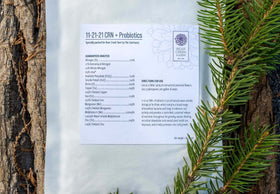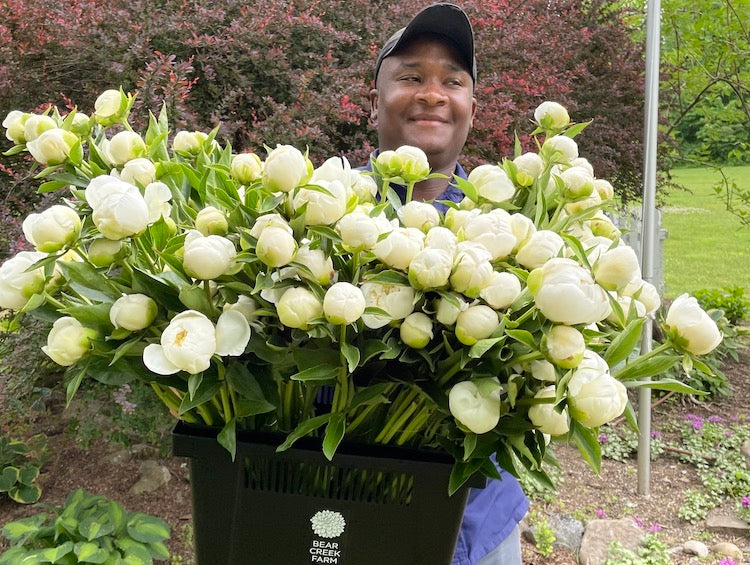Peonies mark summer. As the weather turns warm, the earth roars quietly back. Suddenly, there are colors. The trees spring into bloom, and the tendrils of grass push up. The sun delivers not just promises, but heat too. The early morning chill vanishes.
And the peonies appear. That early summer flower points directly to the universal human yearning that the days be long, and the summer mornings many, wrote the poet Constantine Cavafy in Ithaca. (A poem about uncertain journeys offering rewards, just the same - seems fitting for a gardener.)
We at Bear Creek Farm view flower farming as an extended network. We did not want to let this season pass without finding a few minutes to share with our friends the easy basics in our quest to grow that gloriousness - also called a peony. Note that we are referring here to the herbaceous varieties, also referred to as bush peonies.
Below, please find a list of questions we have gathered - and answers to accompany them.

Planting Peonies
I have purchased some peonies. Now what? How do I plant them?
- Peonies need sun. So much sun. Peonies need at least 6 hours a day of direct sunlight.
- Peonies have soil requirements in order to thrive. Peonies need well-drained soil and good ventilation. Make sure that the patch of earth you prepare offers these attributes.
- Plant your peonies in the fall, so that the bare roots can become established, relaxing into the soil. In other words, consider where the spring and summer sunlight are most abundant, and where the soil breathes and drains well.
- When planting a peony, loosen the soil, so that the roots can settle in and find their own nestled sweet spot. Mix in a handful of daffodil or tulip fertilizer with the soil before covering the plant.
- Allow adequate space between plantings. Make sure to allow 36” between plantings, lay the root in the prepared area with root eyes pointing upward, and cover with soil.
- Do not cover your peony too much or bury too deep. Note that there should only be 2” of soil over the eyes of the root – even in a cold climate.
-
Water your freshly planted peonies. Water the just planted peonies. Afterwards, gently pat the area to remove any air pockets. (Remember to ensure that no more than two inches of soil cover your new-made plantings.)

Growing Peonies
It is warming up. I’m seeing some stirring - it’s working. Now what do I do?
- When the evidence of your work becomes apparent, take a moment to take it in. When spring creeps in, like a perhaps hand (we are feeling poetic this morning, thank you ee cummings), there is still work to be done.
- Fertilize. When the shoots begin to appear in the spring, make sure to fertilize the surrounding soil, once more, with some daffodil or tulip fertilizer. (N.B. make sure to do this in the fall as well, as these bushes or plantings begin their off-season slumber.)
- Don’t let the grass grow under the peonies. Do not have grass growing in the area directly surrounding your peonies. Grass can frustrate the ability of peonies to draw the nutrition they need to speak fluent peonese as their root systems communicate and thrive.
- Make sure to cut a spent bloom after it begins to fade. This is known as “deadheading”. The removal of a now past gift-of-bloom enables the plant to focus efforts on nurturing its success for next season, rather than trying to keep a beauty past its peak going.
- To deadhead, cut the bloom to the first leaf joint from the top of the flower. This saves food for next year’s offering because the seed is not maturing in flower.
- Maintain moderate soil moisture during the summer. Peonies don’t like dry conditions, but neither do they like to be drenched.
- As the seasons change, don’t forget about your peonies. Remove and dispose of fall foliage after autumn freeze - as those late fall mornings begin to hint at winter.
-
Don’t bury your peonies in soil. No matter how tempting one may find it to offer extra protection from the elements, remember that you want only 2” of soil covering the upward facing eyes of the root. (Make eye contact with your beauty before tucking it in for the season – you will see it again, come spring and summer.)

Disbudding
What is the best way to make my peonies lush? Talk to me about disbudding.
- Be strategic in this process. Disbudding is removing the smaller buds on the main flower stem. It is optional. If you choose not to disbud, the center flower blooms first. The sides offer a second bloom.
- Respect the equilibrium of the bloom. Disbud for a larger center flower and to reduce the overall weight of the stems so that the plant is better able to stay upright in the rain.
- About side buds. Remove side buds when they are the size of a pea. Push side bud stem between the main stem and the small leaf beside it so that it *pops* off at the base.





I have grown peonies from the time I helped my grandmother in her beautiful garden. That is about 70 years ago. I still enjoy her favorite one in my garden and have separated it and given it away many times.
thank you for the tips
Great info
Loved the info and the poetic references!